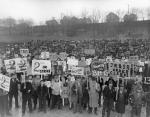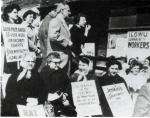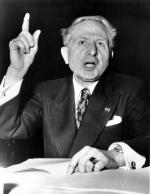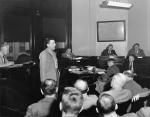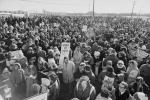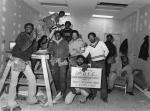Chapter Four: Hot and Cold War
Unions benefited from the huge surge in industrial production in Pennsylvania during World War II. By the end of the war, women represented 16 percent of the state's workforce, and many in a second great migration of southern African Americans to the North poured into steel mills, textiles factories, and shipyards. In return for an agreement by the
During the war, SWOC became the United Steelworkers of America. In 1942, workers at the
Unionized workers were less successful in other sectors. President Roosevelt pressured the AFL and CIO for no-strike pledges to guarantee continued production and fewer disputes, and when the federal government froze wages and prices in 1943, workers exploded in Pennsylvania mining districts. UMW president John L. Lewis called a strike of the bituminous and anthracite miners in 1944, but the federal government seized the mines and then temporarily took over the railroads as well.
After the war, prohibitions on pay raises and promotions were lifted and a surge of workers tried to "catch us up to labor's rightful economic condition." Although many African-American men stayed on in steel, electrical, and rail industries, many women went home. In the Wyoming Valley garment district, however, wives and daughters kept working in appalling conditions doing piece work at break-neck pace. Workers in the
Enlisting the aid of the United Mine Workers and the Teamsters, garment workers spoke out for the ILGWU and joined educational reform leagues. Activist
Concerns about worker safety and the environment also surfaced more frequently after the war. The effects of tedious hours standing at machinery and rising costs of higher education were incorporated into union demands, and fringe benefits became a common point of negotiation for the AFL-CIO. Workers in iron and steel protested the noxious waste and fumes at the
As hot war turned into the Cold War, unions also faced growing public hostility against wage gains that were blamed for intensifying inflation. Within this context, Congress passed the Taft-Hartley Act in 1947, over Harry S. Truman's veto, which limited the economic rights of unions and required loyalty oaths to the government. The oath led to the expulsion of nine unions from the CIO in 1949 and the silencing of leftists across Pennsylvania.
Competing unions in the same industries added fuel to these tensions. For example, the International Union of Electronic, Electrical, Salaried, Machine and Furniture Workers (IUE) pitted its concerns against the more radical United Electrical Radio and Machine Workers of America (UE). In the midst of vicious union in-fighting, UE president
In Pittsburgh, strident anti-communist Justice
But if this merger gave more strength in numbers, it did not protect Pennsylvania unions against the economic recessions that came in waves after 1950. Deindustrialization took root in towns and cities that were home to the oldest basic work sectors, including Allentown,
Unions fought hard to save jobs in the traditional manufacturing and processing sectors. The steelworkers led with angry and well-organized, but largely unsuccessful strikes in 1952 and 1959, and then faced huge layoffs. From the 1950s to the 1980s, the Monongahela Valley's miners and steel workers faced heartbreaking decline. Pittsburgh, the country's industrial capital in 1950, witnessed a downward spiral toward nearly 40 percent unemployment in industrial jobs by 1985. Companies migrated into new regions and new countries, where labor was cheaper and nonunion; trucking overtook much of Pennsylvania's industrial railroad transporting, and surface mining replaced well-paid underground mining jobs.
Could there be life for the union movement under such conditions? In 1969, UMW leader
In 1970, the Public Employees Relations Act established collective bargaining for teachers and other public workers.
By the 1980s, strikes were less violent and shorter, and their number dropped from 470 in 1952 to a record low of 29 in 1997. In the 1980s, employers replaced striking union workers with nonunion labor. President Ronald Reagan signaled the new direction of the federal government and courts when he ordered the replacement of 8,590 members of the Professional Air Traffic Controllers Organization (PATCO) after they struck in 1981. Emboldened by his lead, private-sector employers stepped up their own campaigns to cut wages, employ strikebreakers, hire union-busting consultants, and raid pension funds.
American private sector union membership dropped from a high of more than 35 percent of the workforce in 1948 to less than 12 percent nationwide by 2000. In this period, Pennsylvania created tens of thousands of new jobs in real estate, finance, insurance, electronics, biotechnology, pharmaceuticals, and other high-technology industries, but few of the new workers were organized. By 2002, only 15 percent of Pennsylvania's 5,452,000 employed wage and salary workers were unionized, and only one white-collar worker in eight was unionized. In the more unionized public sector, wages and healthcare benefits barely kept pace with inflation after 1980.
Unions have responded to global and company-based pressures with novel solutions. Some are building coalitions with social movements. Others are combining unions from related occupations into single bargaining units. Still others are hoping to make multinational corporations accountable to their employees in the United States. But more workers are performing their jobs in multiple locations, working longer hours, and facing racial and linguistic barriers.
Migrant workers have faced especially rigid barriers to forming unions in construction and






